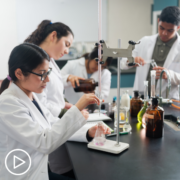Does CLL Research Show Potential for a Cure?
Does CLL Research Show Potential for a Cure? from Patient Empowerment Network on Vimeo.
Could chronic lymphocytic leukemia (CLL) research potentially bring a cure for patients? Dr. Danielle Brander shares her perspective about the future of CLL care, functional cure, and cure-like condition.
Dr. Danielle Brander is an Assistant Professor in the Division of Hematologic Malignancies & Cellular Therapy at Duke University Medical Center. Learn more about Dr. Danielle Brander.
Download Resource Guide | Descargar Guía en Español
Related Programs:

Chronic Lymphocytic Leukemia Prognosis and Treatment Factors |

Chronic Lymphocytic Leukemia Research and EVOLVE Trial Updates |

Common Chronic Lymphocytic Leukemia Symptoms and Follow-Up Tests |
Transcript:
Lisa Hatfield:
So as a cancer patient, one of the biggest questions I had when I was diagnosed, you hear the word “cancer” or in this case “CLL leukemia.” Two questions. One of them, is there a cure for CLL? And if not, are there any trials looking at a cure for CLL?
Dr. Danielle Brander:
Yes. Excellent. An understandable question. Traditionally, we say that CLL or others slower-growing, or sometimes you’ll hear the term indolent lymphomas, do tend to be slower-growing. Some patients don’t need treatment. But the flip side of that is we generally think of them as not curable, that they’re a chronic condition and that treatment, the goal of treatment is to knock it down and relieve whatever symptoms or indications or reasons your starting treatment are.
But at some level, we historically think of CLL as either eventually coming back or sticking around, so to speak. However, I think most oncologists, most those in the field, feel that some of the treatments that are around or in combination, that we’re going to have some patients that have maybe what a term might be functional cure or individual, cure-like condition.
Meaning if our newer treatments for some patients can knock down the CLL so much that it either doesn’t come back or take so long to even show itself again, in a way that serves as what the purpose of cure, really is, which is to get it down to levels that it’s not causing problems or not coming back, for the lifetime of the patient.
Bone marrow transplant is the only therapy historically that has been cured, has offered a cure for some patients. The downside and the reason that most patients aren’t referred to for bone marrow transplant is the risk side of it. Meaning, unfortunately, a bone marrow or stem cell transplant has such a high risk of directly causing side effects.
That could be life-limiting or chronic side effects from the transplant itself versus the agents available now that we aren’t using or referring to bone marrow transplant nearly as much, but I think it’s really encouraging what we’re seeing in responses. So we talked already about those main categories of BTK inhibitors or venetoclax, I didn’t yet talk about, but there are many trials that have looked at those in combination, or CAR T, for example, or bispecific antibodies that are knocking down the CLL to such low levels. But the hope is that serves as a way of functional cure. But it’s going to take time to see if that’s the case. But we’re all very encouraged and really believe that that’s on the horizon.
Share Your Feedback
Create your own user feedback survey










